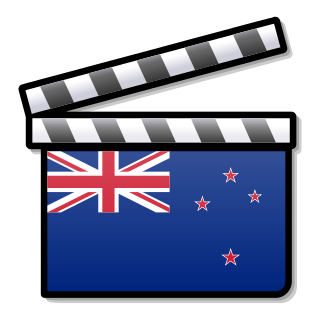Related Research Articles

Laos, officially the Lao People's Democratic Republic, is the only landlocked country in Southeast Asia. At the heart of the Indochinese Peninsula, Laos is bordered by Myanmar and China to the northwest, Vietnam to the east, Cambodia to the southeast, and Thailand to the west and southwest. Its capital and largest city is Vientiane.

New Zealand cinema can refer to films made by New Zealand-based production companies in New Zealand. However, it may also refer to films made about New Zealand by filmmakers from other countries. Due to the comparatively small size of its film industry, New Zealand produces many films that are co-financed by overseas companies.
The film industry or motion picture industry comprises the technological and commercial institutions of filmmaking, i.e., film production companies, film studios, cinematography, animation, film production, screenwriting, pre-production, post-production, film festivals, distribution, and actors. Though the expense involved in making films almost immediately led film production to concentrate under the auspices of standing production companies, advances in affordable filmmaking equipment, as well as an expansion of opportunities to acquire investment capital from outside the film industry itself, have allowed independent film production to evolve.

Ko Samui is an island off the east coast of Thailand. Geographically in the Chumphon Archipelago, it is part of Surat Thani Province, though as of 2012, Ko Samui was granted municipal status and thus is now locally self-governing. Ko Samui, with an area of 228.7 square kilometres (88.3 sq mi), is Thailand's second largest island after Phuket. In 2018, it was visited by 2.7 million tourists.

Pattaya is a city in Eastern Thailand, the second-largest city in Chonburi province and the eighth-largest city in Thailand. It is on the east coast of the Gulf of Thailand, about 100 kilometres (62 mi) southeast of Bangkok, and has a population of 328,961 as of 2021.

Thái Nguyên is a province in the Northeast region of Vietnam. It is a mountainous, midland province with a natural land area of 3,526.64 square kilometres (1,361.64 sq mi) and a population of 1,286,751 as of 2019. Its multi-ethnic society is composed of eight ethnic groups.

The cinema of Thailand dates back to the early days of filmmaking, when King Chulalongkorn's 1897 visit to Bern, Switzerland was recorded by François-Henri Lavancy-Clarke. The film was then brought to Bangkok, where it was exhibited. This sparked more interest in film by the Thai Royal Family and local businessmen, who brought in filmmaking equipment and started to exhibit foreign films. By the 1920s, a local film industry was started and in the 1930s, the Thai film industry had its first "golden age", with a number of studios producing films.
Miss Suwanna of Siam, was a 1923 romance film written and directed by Henry MacRae, set in Thailand and starring Thai actors. It was one of the first feature films to be made in Thailand and was the first Hollywood co-production in Thailand.

Cinema in Cambodia began in the 1950s, and many films were being screened in theaters throughout the country by the 1960s, which are regarded as the "golden age". After a near-disappearance during the Khmer Rouge regime, competition from video and television has meant that the Cambodian film industry is a small one.

Tourism is an economic contributor to the Kingdom of Thailand. Estimates of tourism revenue directly contributing to the GDP of 12 trillion baht range from one trillion baht (2013) 2.53 trillion baht (2016), the equivalent of 9% to 17.7% of GDP. When including indirect travel and tourism receipts, the 2014 total is estimated to be the equivalent of 19.3% of Thailand's GDP. The actual contribution of tourism to GDP is lower than these percentages because GDP is measured in value added not revenue. The valued added of the Thailand's tourism industry is not known. According to the secretary-general of the Office of the National Economic and Social Development Council in 2019, the government projects that the tourism sector will account for 30% of GDP by 2030, up from 20% in 2019.

The Legend of King Naresuan is a Thai biographical historical drama film series about King Naresuan the Great, who ruled Siam from 1590 until his death in 1605.

The North Carolina Film Office, originally called the North Carolina Film Commission, is a member of the Association of Film Commissioners International.

The cinema of Uruguay has a role in the culture of Uruguay and is a part of Latin American cinema. Since the late 1990s, Uruguayan cinema has undergone a process of evolution, during which its films have received positive reviews and been internationally recognized. Over 120 films, fiction and non-fiction, have been produced since then.

Bilateral relations between the Kingdom of Thailand and the United States of America date back to 1818. Thailand and the United States have long been close allies and diplomatic partners.

Denmark–Thailand relations date back to 1621. Denmark operates an embassy in Bangkok, along with a consulate in Phuket, although it used to have one in Pattaya. The Danish embassy in Bangkok also handles Danish relations with Cambodia, with the current Danish ambassador of Thailand also being the ambassador to Cambodia. Thailand itself operates an embassy in Copenhagen.

Rice production in Thailand represents a significant portion of the Thai economy and labor force. In 2017, the value of all Thai rice traded was 174.5 billion baht, about 12.9% of all farm production. Of the 40% of Thais who work in agriculture, 16 million of them are rice farmers by one estimate.
Emrah Yucel, is a Turkish advertising and graphic designer based in Los Angeles, USA. He specialized in motion picture advertising as well as country and city branding.

Bilateral relations between the Republic of Singapore and the Kingdom of Thailand formally date to 1965, when Thailand established diplomatic relations soon after the independence of Singapore. Both countries are the founding members of the Association of Southeast Asian Nations.

The film industry of Malta consists primarily of location shooting for larger foreign productions. The Maltese landscape has portrayed several different regions of the world, and the Maltese government provides incentives for foreign productions to operate in Malta. The prevalence of location shooting in the country has created a large film tourism industry. Malta has also had a limited number of local productions of Maltese films.